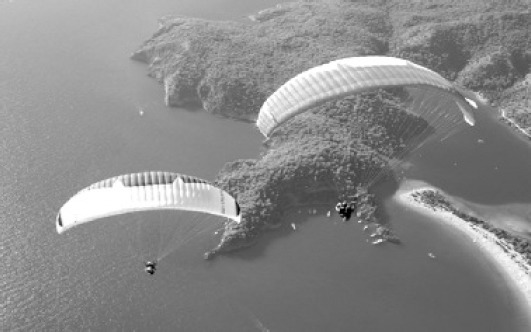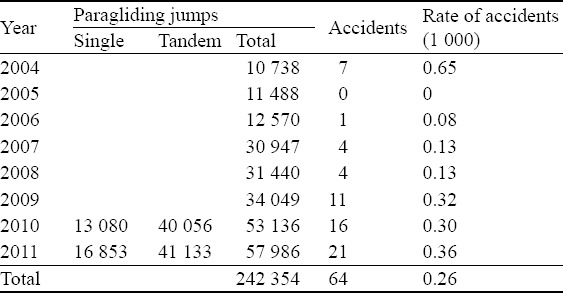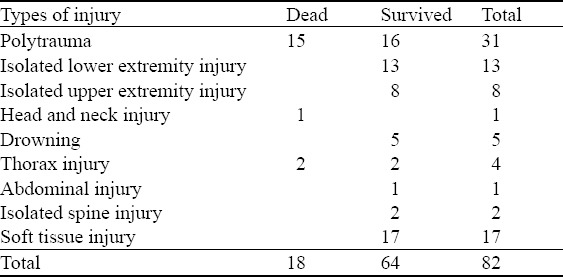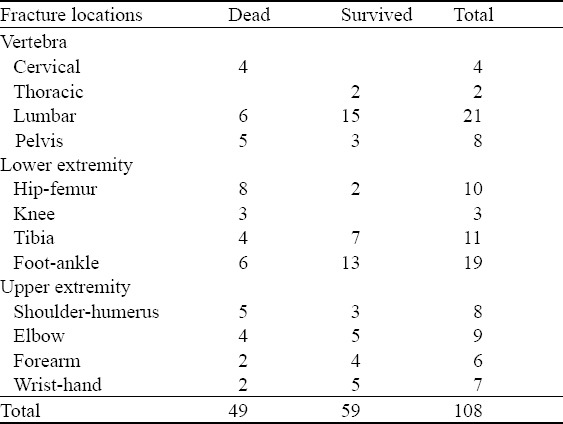Abstract
BACKGROUND:
This study was undertaken to analyze the characteristics and risk factors relating to fatalities and injuries caused by paragliding.
METHODS:
The judicial examination reports and hospital documents of 82 patients traumatized in 64 accidents during 242 355 paragliding jumps between August 2004 and September 2011 were analyzed.
RESULTS:
In these accidents, 18 of the 82 patients lost their lives. In the patients with a confirmed cause of accident, most of them were involved with multiple fractures and internal organ injuries (n=8, 44.4%).
CONCLUSION:
We investigated the incidence of paragliding injuries, the types of the injuries, and the severity of affected anatomical regions. The findings are significant for the prevention of paragliding injuries and future research.
KEY WORDS: Paragliding accidents, Injuries, Turkey
INTRODUCTION
Paragliding is an adventure (extreme) sport and can be performed either individually or in tandem (accompanied by a pilot) using a specially designed parachute. Paragliding was first introduced in 1940 and has gained popularity after the 1980s. Design and equipment have been refined until then.[1,2] This sport has gained popularity worldwide since its equipment is more affordable and easier to obtain than other kinds of aerial sports, and moreover, it does not require any logistical support such as an airport. It has been performed over Baba Mountain in the region of Fethiye in Turkey since the early 1990s (Figure 1).
Figure 1.

Thousands of domestic and foreign tourists perform paragliding jumps each year.
Fethiye Baba Mountain is one of the favorite paragliding regions in Turkey. Paragliding injuries are more uncommon than other types of trauma injuries.[2] The number of accidents that usually cause high energy trauma and subsequent morbidity or mortality has tended to increase in this sport correlatively with the increasing number of flights.[3,4]
The main objective of our retrospective study was to determine the characteristics of injuries related to paragliding accidents at the Fethiye region and to provoke the awareness of people about precautions.
METHODS
Eighty-two patients who were injured in 64 paragliding accidents between August 2004 and September 2011 were reviewed from judicial medical reports and data from three hospitals at the Fethiye region. The severity of traumas that patients were exposed was classified as minor (no need for hospitalization), serious (need for hospitalization) and mortal. A data sheet consisting of demographic data, physical and radiological findings, characteristics of flights, time of accident (take-off, mid-air or landing) and accident reports of the 64 accidents was composed. Moreover, autopsy reports of 18 deaths were obtained. Permission must be obtained from the Ministry of Justice to assess the paragliding accident reports that have been delivered to the district public prosecutor.
Data about the number, patterns and paths of the flights were obtained primarily from Turkey Paragliding Association and Fethiye Guc Birligi Turizm Tanitma Ticaret Limited Company. Since the records did not contain either the number of flights until the year of 2007 or patterns and paths of the flights until the year of 2010, records of 2010 and 2011 were utilized for statistical evaluation. Paragliding injuries without hospital or accident reports and happened outside of the Fethiye region were excluded. All analyses were performed with SPSS 15.0 for Windows®. P<0.05 was considered as statistically significant.
RESULTS
A thorough review of records revealed 64 of 242 355 paragliding flights ended with accidents. Eighty-two people faced to accidents, 18 of whom were dead and 64 were injured, were recorded. Sixty-nine (84.2%) were male and 13 (15.8%) were female. Their mean age was 37.5 years (18–71). Thirty-eight (46.3%) people were from Turkey and 44 (53.7%) were tourists.
The number of flights has increased progressively since the beginning of the last decade. The number of flights and accidents in the Baba Mountain between 2004 and 2011 are shown in Table 1. Twenty tandem flights and 44 single flights ended with an accident. Thirteen were single and 5 were in tandem flights of all 18 accidents that caused death. Thirty-one patients were injured during single flights and 33 were injured during tandem flights (Table 2). The number of accidents that occurred during the individual flights was significantly higher than that occurred during the tandem flights (P<0.05).
Table 1.
Annual flight count, types of flights and number of accidents

Table 2.
Number of deaths and injuries according to the types of flights

Of all patients who were recorded, 27 were injured during take-off (33%), 45 were injured in mid-air (55%), and 10 were injured during landing (12%) (Table 3). We determined that the mortality rate was significantly higher in accidents occurred in mid-air (P<0.05).
Table 3.
Distribution of patients during flight phase

In 18 (22%) deaths recorded, 14 were male (77.7%) and most of them had multiple fractures (n=15, 83.3%). The primary causes of deaths included 7 (38.9%) major artery injuries, 6 (33.3%) intracranial hemorrhages, 3 (16.7%) cervical fractures and 2 (11.1%) pneumothoraxes respectively.
Sixty-four patients survived after a paragliding accident. Seventeen (20.7%) patients were discharged from the emergency department after treatment for soft tissue trauma, abrasion or sprain without any serious health problem. Sixteen multiple fractures, 13 isolated lower extremity fractures and 8 isolated upper extremity fractures were detected in the survived patients (Table 4).
Table 4.
Distribution of injuries after paragliding accidents

One hundred-eight orthopedic fractures were seen in these paragliding accidents. The most common were lumbar fractures (n=21, 19.4%), fractures around the foot and ankle (n=19, 17.6%), and tibia fractures (n= 11, 10.2%), respectively (Table 5). Thirty-four (82.9%)patients underwent surgery after hospital admission. The mean length of hospital stay was 18.3 days.
Table 5.
Distribution of orthopaedic injuries after paragliding accidents

DISCUSSION
In this study we found the increased number of paragliding accidents is correlated with the increasing number of flights. Schulze et al[5] reported that accidents have a tendency to decline in number as years passed away. Additionally, Bohnsack et al[6] found that the number of paragliding accidents reduced in comparison with other aerial and motorcycle accidents. We think that the precautions taken for preventing paragliding accidents are insufficient in Turkey since the number of accidents tends to increase.
In our series, 84.2% of patients were male and 15.8% were female. Gender distribution of our patients was consistent with that of reports about accidents in modern aerial and adventure sports.[3,7] The mean age of the patients was also consistent with that reported in the literature.[1,2,8,9]
Our review of the literature did not show any studies reporting a comparison of the characteristics of injuries between single and tandem paragliding accidents. Our results suggested that the rate of paragliding accidents is significantly higher in individual flights than in tandem flights (P<0.05). These results suggested that flight experience of pilots about flight limits, condition of airbase during landing and take-off, and maneuvering in different weather conditions may minimize the risk of accident in tandem flights. Moreover, people tend to make some unnecessary acrobatic moves during individual flights which maximize the risk of accident.
There are various reports about paragliding injuries in the literature. The paragliding injury rate varies from 120 to 360 per 100 000 jumps.[4,5,8,10–12] We found an accident rate of 26 per 100 000 jumps in our study. We thought that exclusion of accidents with no judicial medical reports or no admission to hospital may be responsible for this low value. According to the testimonies of witnesses the most common reasons of accidents were recorded as reverse wind, air turbulence, sudden closure of wings, misalignment of ropes and hard landing. Adverse weather conditions were certainly the most important issue for the risk of accident.
The mortality rate of paragliding jumps in this study was found as 7/100 000. Fasching et al[3] from Germany reported a mortality rate of 45/100 000 in paragliding jumps. Krüger-Franke et al[5] reported three deaths in 218 paragliding accidents. Amamilo et al[6] declared a mortality of 0.06%–0.035% and an injury rate of 0.32%–0.5% between 1997 and 2003.
The injury rate of paragliding was found to be lower than that of other adventure and extreme sports, but the accidents were more fatal.[3] The most catastrophic injuries of the pilots were fractures (42.9%–89%).[3,13,14] These fractures occurred mostly at the lower extremities (29%–56%) especially around the ankle.[2,4,9] In our study, a lower extremity fracture rate was 39.8% (n=43), which was consistent with that reported in the literature.
In our study, mortal accidents occurred in mid-air (n=17, 94.4%). The most frequent detectable causes of the accidents were human errors and folding of the parachute during flight in bad weather conditions. About one third of the causes were undetectable.
In our study, the paragliders did not use protective equipment except a simple helmet. In Turkey, paragliding can be performed with a certificate that is given by the Turkish Aeronautical Association after a two-week training course. Reports suggested that by refinement of pilot education, deliberate use of protective equipment, and better understanding of inherent aerodynamics of paragliding, the injury rates can be lowered.[2,6,17,18]
In our study, only patients admitted to hospitals were reported as having injuries. Obtaining results from only one specific touristic region is one of limitations of this study. A country-wide database should be established to determine the national incidence of paragliding injury and risky regions for paragliding. These would refine the precautions and provide immediate intervention to accidents and medical support for patients.
Most countries have a federation of paragliding.[2,3,9] A national federation of paragliding exists in Turkey but it has a limited field of practice.
In conclusion, it is essential to annually renew certificates of paragliding pilots and to take more precautions to minimize the risk of accidents. Since most death injuries happen in mid-air, more attention should be paid to the period of seasonal transition when wind speed and direction change improbably. To decrease the injury risk of extremities, proper protective equipment should be used by pilots and tandem paragliders. Also, regular education-programs should be given to paragliders for the improvement of their mentality and practical skills. More studies should be conducted to obtain countrywide results and build a database about paragliding accidents.
Footnotes
Funding: None.
Ethical approval: The ethical approval was obtained from the Ethical Review Committee, Muğla Sıtkı Koçman University, Mugla, Turkey.
Conflicts of interest: We do not have any conflicts of interest.
Contributors: All authors conceived the study, developed the proposal, involved in data collection, data analysis, and manuscript preparation. All authors approved the final version of the article.
REFERENCES
- 1.Gauler R, Moulin P, Koch HG, Wick L, Sauter B, Michel D, et al. Paragliding accidents with spinal cord injury: 10 years’ experience at a single institution. Spine (Phila Pa 1976) 2006;31:1125–1130. doi: 10.1097/01.brs.0000216502.39386.70. [DOI] [PubMed] [Google Scholar]
- 2.Schulze W, Richter J, Schulze B, Esenwein SA, Büttner-Janz K. Injury prophylaxis in paragliding. Br J Sports Med. 2002;36:365–369. doi: 10.1136/bjsm.36.5.365. [DOI] [PMC free article] [PubMed] [Google Scholar]
- 3.Fasching G, Schippinger G, Pretscher R. Paragliding accidents in remote areas. Wilderness Environ Med. 1997;8:129–133. doi: 10.1580/1080-6032(1997)008[0129:paira]2.3.co;2. [DOI] [PubMed] [Google Scholar]
- 4.Schulze W, Hesse B, Blatter G, Schmidtler B, Muhr G. Pattern of injuries and prophylaxis in paragliding. Sportverletz Sportschaden. 2000;14:41–49. doi: 10.1055/s-2000-7439. [DOI] [PubMed] [Google Scholar]
- 5.Krüger-Franke M, Siebert CH, Pförringer W. Paragliding injuries. Br J Sports Med. 1991;25:98–101. doi: 10.1136/bjsm.25.2.98. [DOI] [PMC free article] [PubMed] [Google Scholar]
- 6.Amamilo SC, Samuel AW, Hesketh KT, Moynihan FJ. A prospective study of parachute injuries in civilians. J Bone Joint Surg Br. 1987;69:17–19. doi: 10.1302/0301-620X.69B1.3818726. [DOI] [PubMed] [Google Scholar]
- 7.Rekand T. The epidemiology of injury in hang-gliding and paragliding. Med Sport Sci. 2012;58:44–56. doi: 10.1159/000338581. [DOI] [PubMed] [Google Scholar]
- 8.Ekerhovd KM, Novomesky F, Komarekova I, Strak L. Descriptive epidemiological study of fatal incidents and injury mechanisms among civilian sport parachutists in Norway from 1963 to 2008. Rom J Leg Med. 2013:31–36. [Google Scholar]
- 9.Rekand T, Schaanning EE, Varga V, Schattel U, Gronning M. Spinal cord injuries among paragliders in Norway. Spinal Cord. 2008;46:412–416. doi: 10.1038/sj.sc.3102158. [DOI] [PubMed] [Google Scholar]
- 10.Bohnsack M, Schröter E. Injury patterns and typical stress situations in paragliding. Orthopade. 2005;34:411–418. doi: 10.1007/s00132-005-0795-8. [DOI] [PubMed] [Google Scholar]
- 11.Ekeland A. Injuries in military parachuting: a prospective study of 4499 jumps. Injury. 1997;28:219–222. doi: 10.1016/s0020-1383(96)00185-4. [DOI] [PubMed] [Google Scholar]
- 12.Ellitsgaard N. Parachuting injuries: a study of 110,000 sports jumps. Br J Sports Med. 1987;21:13–17. doi: 10.1136/bjsm.21.1.13. [DOI] [PMC free article] [PubMed] [Google Scholar]
- 13.Exadaktylos AK, Sclabas G, Eggli S, Schönfeld H, Gygax E, Zimmermann H. Paragliding accidents—the spine is at risk. A study from a Swiss Trauma Centre. Eur J Emerg Med. 2003;10:27–29. doi: 10.1097/00063110-200303000-00008. [DOI] [PubMed] [Google Scholar]
- 14.Feletti F, Goin J. Accidents and injuries related to powered paragliding: a cross-sectional study. BMJ Open. 2014;4:e005508. doi: 10.1136/bmjopen-2014-005508. [DOI] [PMC free article] [PubMed] [Google Scholar]
- 15.Munro BJ, Dassen J, Wijnen A, Fogg C, Steele JR. Fiji: 2004. Oct, What is the nature of hang gliding injuries in Australia? Asics Conference of Science and Medicine in Sport. [Google Scholar]
- 16.Sözüer EM, Ozkan S, Akdur O, Durukan P, Ikizceli I, Avşaroğullari L. Injuries due to parachute jumping. Ulus Travma Acil Cerrahi Derg. 2008;14:201–204. [PubMed] [Google Scholar]
- 17.Zeller T, Billing A, Lob G. Injuries in paragliding. Int Orthop. 1992;16:255–259. doi: 10.1007/BF00182706. [DOI] [PubMed] [Google Scholar]
- 18.Dawson M, Asghar M, Pryke S, Slater N. Civilian parachute injuries;10 years on and no lessons learned. Injury. 1998;29:573–575. [PubMed] [Google Scholar]


